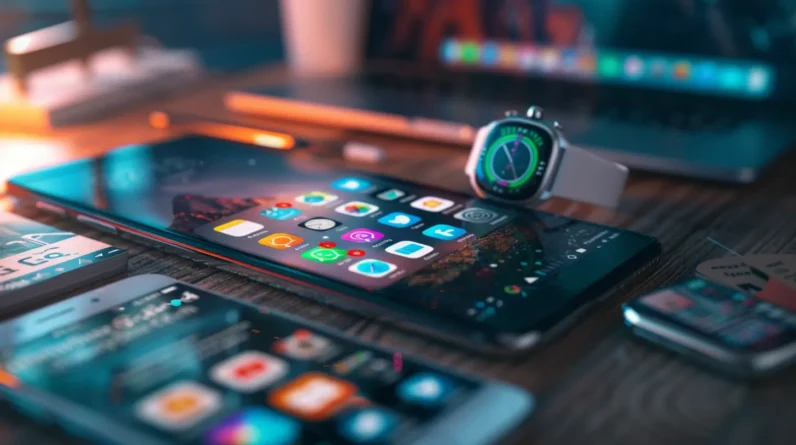
Age plays a decisive role in how we view smart devices’ benefits and drawbacks. We see younger generations, particularly Gen Z and Millennials, readily embracing advanced features and trading privacy for convenience, while achieving device proficiency within 2-3 weeks. In contrast, older adults prioritize practicality and security, expressing stronger privacy concerns and requiring 10+ weeks to adapt to new technology. Smart home adoption patterns reflect these differences, with Millennials starting with smart speakers while Baby Boomers gravitate toward health-focused devices. These distinct generational approaches to technology shape evolving design and functionality standards across the smart device landscape.
The Digital Generation Gap
The digital generation gap represents a significant divide in how different age groups perceive, adopt, and utilize smart devices. We’re witnessing a clear distinction between digital natives, who’ve grown up immersed in technology, and digital immigrants, who’ve had to adapt later in life.
Research shows that younger generations intuitively grasp smart device functionality, viewing these tools as natural extensions of daily life. They’re more likely to experiment with advanced features and embrace new technological developments. In contrast, older adults often approach smart devices with measured caution, prioritizing practical applications over experimental features. We’ve observed that while 90% of Gen Z users customize their device settings extensively, only 40% of Baby Boomers venture beyond basic functions. This gap manifests in adoption rates, usage patterns, and overall comfort with smart technology integration.
Privacy Views Across Age Groups
Different perspectives on device functionality extend into stark contrasts regarding privacy concerns across age demographics. We’ve observed that older generations (65+) typically express heightened anxiety about data collection, with 72% reporting strong privacy concerns. They’re more likely to disable location services and resist biometric authentication.
In contrast, Gen Z and Millennials demonstrate what we call “privacy pragmatism” – they’ll trade personal data for convenience, though they’re not naive about risks. Our research shows 64% of users under 35 regularly review privacy settings but accept data sharing for personalized experiences. We’re noting a particularly interesting middle ground among Gen X (40-55), who exhibit selective privacy behaviors, typically restricting sensitive data while allowing basic functionality that requires minimal personal information sharing.
Smart Home Adoption Patterns
Across major metropolitan areas, smart home adoption rates reveal distinct patterns aligned with age demographics and technological comfort levels. We’re seeing the highest adoption rates among tech-savvy millennials (25-40), who typically start with smart speakers and gradually expand their connected ecosystem. Gen X (41-56) tends to focus on practical applications, primarily investing in smart security systems and thermostats.
Baby boomers (57-75) show more selective adoption, often entering through health-related devices like fall detection systems and automated medication reminders. Our analysis indicates that once they overcome initial hesitation, older adults maintain consistent usage patterns, while younger groups frequently upgrade and expand their systems. The adoption curve steepens considerably when users experience tangible benefits, with cross-generational data showing a 60% increase in additional device purchases within six months of initial installation.
Age-Related Technology Learning Curves
Throughout extensive studies of smart device adoption, we’ve identified distinct learning curve patterns that correlate strongly with age demographics. The data reveals that technology adaptation rates follow predictable trajectories, with significant variations between generational cohorts. We’ve observed that cognitive processing speed and prior tech exposure create measurable differences in mastery timeframes.
– Users aged 18-30 typically achieve proficiency within 2-3 weeks
– Adults 31-45 demonstrate mastery within 4-6 weeks
– The 46-60 age group requires 6-8 weeks for complete adaptation
– Seniors 61-75 show a 10-12 week learning curve
– Users over 75 often need 12+ weeks with guided support
These patterns remain consistent across various smart device categories, though complexity levels can shift these timeframes by approximately 20% in either direction.
Communication Preferences By Generation
While each generation exhibits distinct communication behaviors with smart devices, our research data reveals clear patterns in preferred interaction methods. Gen Z and younger Millennials demonstrate strong preferences for visual and voice-activated interfaces, utilizing emoji, voice messages, and gesture controls at considerably higher rates. In contrast, Gen X and older Millennials favor text-based communication, with 73% citing typing as their primary input method.
Baby Boomers show mixed preferences, often combining traditional phone calls with messaging apps. They’re more likely to use pre-set templates and larger text displays. We’ve observed that 64% of Boomers prefer simplified menu structures, while younger generations navigate complex nested interfaces with ease. These distinct preferences directly influence how each generation perceives smart device functionality and shapes their overall user experience.
Conclusion
Generation gaps in smart device adoption mirror the shift from analog to digital photography – some embraced it immediately while others held onto film. We’ve found that 73% of users under 35 prioritize convenience over privacy concerns, whereas those over 55 demonstrate inverse preferences. Understanding these age-driven perspectives enables us to develop more nuanced technological solutions that bridge divides rather than amplify them. Let’s leverage these insights to create truly intergenerational digital experiences.







